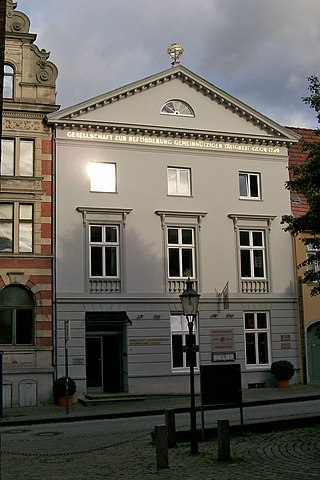Top Qs
Timeline
Chat
Perspective
Gesellschaft zur Beförderung gemeinnütziger Tätigkeit
From Wikipedia, the free encyclopedia
Remove ads
The Gesellschaft zur Beförderung gemeinnütziger Tätigkeit ("Society for the Furtherance of Charitable Activities") is Lübeck's oldest charitable organization.


History
Summarize
Perspective
It was the preacher at St. Peter's Church, Lübeck (and later lawyer) Ludwig Suhl (1752–1819) and his friends Christian Adolph Overbeck, Johann Julius Walbaum, Anton Diedrich Gütschow, Gottlieb Nicolaus Stolterfoth, Johann Friedrich Petersen, and Nicolaus Heinrich Brehmer who, on 27 January 1789, founded this charity, first of all as a Literärische Gesellschaft ("literary society") with sidelines of scientific research and education; in 1791 the society's scope was broadened, and in 1793 it acquired the name it still bears today, although it is often abbreviated as the Gemeinnützige.
The democratically structured and middle class society and its social house (from 1826 at the address Breite Strasse 33, and from 1891 at Königstrasse 5) rapidly became the centre of practical reform work in the spirit of the Enlightenment. The company was involved in the improvement of conditions in many areas of life; for example, it established a River Lifesavers Institute. It was associated with the newspaper Neue Lübeckische Blätter and with the Jung-Lübeck, a Vormärz movement.
It ran the Sparkasse zu Lübeck, a credit union, and up to 1934 the Museum of Art and Cultural History. In 1938 their concert, theatre and lecture hall, the Kolosseum, was moved to the Kronsforder Allee.
On its hundredth anniversary in 1889 it received Lübeck's highest honour, the Gedenkmünze Bene Merenti. It is the only incorporated society to win this award. Eight former directors were given medals.
Remove ads
Present
The society has numerous subsidiary societies and unions, which contribute to the cultural and social life of the city. For example, it found a home for the St. Mary's Boys' Choir on the premises of the society in the Bürgergärten. As a trustee it manages a large number of dependent organisations, such as the Ferdinand Heinrich Grautoff-Stiftung.
Directors of the society
Summarize
Perspective
Note. The term of office is three years; immediately following terms are not specifically highlighted in the table, but can be deduced. Additional terms of office, after the term of a different incumbent, are marked by asterisks, so ** indicates a second additional period, and *** indicates a third. The Ratslinie number gives the position in the official register of 1925, Emil Ferdinand Fehling's Ratslinie.
Remove ads
See also
Bibliography
- Friedrich Bruns: Die Lübecker Syndiker und Ratssekretäre bis zur Verfassungsänderung von 1851 in: ZVLGA Band 29 (1938), S. 91 – 168.
- Hermann Stodte: Festschrift zur 150-Jahr-Feier der Gesellschaft zur Beförderung gemeinnütziger Tätigkeit zu Lübeck, begründet 1789. Lübeck 1939.
- Georg Behrens, 175 Jahre Gemeinnütziges Wirken, Lübeck 1964
- Ahasver von Brandt: Das Lübecker Bürgertum zur Zeit der Gründung der "Gemeinnützigen" – Menschen, Ideen und soziale Verhältnisse. In: Der Wagen 1966, S. 18–33.
- Emil Ferdinand Fehling, Lübeckische Ratslinie, Lübeck 1925.
- Vorsteherschaft der Gesellschaft (Hrsg.), 200 Jahre Gesellschaft zur Beförderung gemeinnütziger Tätigkeit in Lübeck 1789–1989, Lübeck 1989
Remove ads
Notes
External links
Wikiwand - on
Seamless Wikipedia browsing. On steroids.
Remove ads





